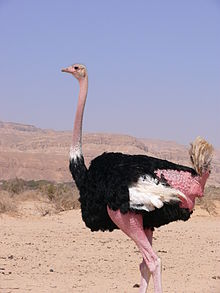North African ostrich
| North African ostrich | |||
|---|---|---|---|
 |
|||
| Male | |||
 |
|||
| Female | |||
| Scientific classification | |||
| Kingdom: | Animalia | ||
| Phylum: | Chordata | ||
| Class: | Aves | ||
| Superorder: | Paleognathae | ||
| Order: | Struthioniformes | ||
| Family: | Struthionidae | ||
| Genus: | Struthio | ||
| Species: | S. camelus | ||
| Subspecies: | S. c. camelus | ||
| Trinomial name | |||
|
Struthio camelus camelus (Linnaeus, 1758) |
|||
 |
|||
Struthio camelus distribution map
|
|||
The North African ostrich or red-necked ostrich (Struthio camelus camelus), also known as the Barbary ostrich, is the largest subspecies of the common ostrich from West and North Africa, making it the largest living bird.
The North African ostrich is the largest subspecies of S. camelus, at 2.74 m (9.0 ft) in height and up to 154 kilograms (340 lb) in weight. The neck is pinkish-red, the plumage of males is black and white, and the plumage of females is grey.
The North African ostrich was once widespread in western and northern Africa. It used to range from Ethiopia and Sudan in the east throughout the Sahel to Senegal and Mauritania in the west, and north to Egypt and southern Morocco. It has now disappeared from large parts of this range and it only remains in 6 of the 18 countries where it originally occurred. This subspecies may also have occurred in the Sinai Peninsula, where Arabian ostriches once lived. North African ostriches can be found in open fields and the savannahs, especially in the Sahel of Africa. In Asia, the introduced North African ostriches live in grasslands, semi-deserts and plains.
The North African ostrich had dramatically declined to the point where it is now included on CITES Appendix I and some treat it as Critically Endangered. The North African ostrich is part of a project by the Sahara Conservation Fund (SCF) with the aim of saving the subspecies from extinction and restore its populations in its former ranges in the Sahara and the Sahel.
...
Wikipedia
